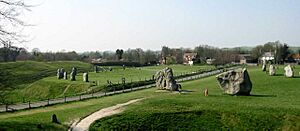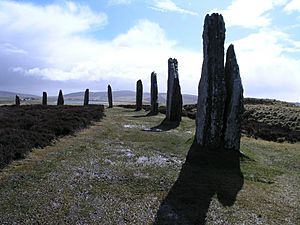Stone circles in the British Isles and Brittany facts for kids
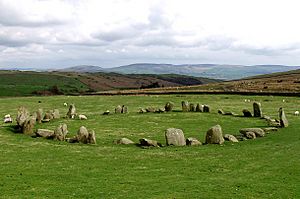
The stone circles in the British Isles and Brittany are ancient monuments. They are made of large standing stones arranged in rings. People built these amazing structures between 3300 and 900 BCE. This was in Britain, Ireland, and Brittany (part of France).
Experts think about 4,000 of these monuments were built long ago. Today, only about 1,300 of them still exist. The others have been destroyed over time.
Stone circles have been built by many societies for different reasons. But this specific tradition was mostly in Britain, Ireland, and Brittany. These rings were not spread evenly. They were found more often in certain highland areas. These include central Scotland, the Lake District, and parts of Ireland.
We don't fully know why these circles were built. But archaeologists have learned some things. Many believe they were used for special ceremonies or rituals. These might have been connected to the sun or moon. Some circles were also used as burial sites for the dead.
People started studying these circles a long time ago. In the 18th century, a scholar named William Stukeley wrote about them. Back then, people didn't know much about ancient Britain. They often thought the circles were built by druids or Danish settlers.
In the 20th century, archaeology helped us learn more. Archaeologists found that the circles were built in the Late Neolithic and Bronze Ages. More recently, some modern pagan groups use these sites. They see them as "sacred places" for their own ceremonies.
Contents
How Stone Circles Began
Life in the Early Stone Age
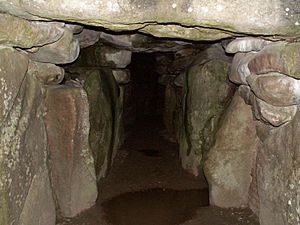
The Neolithic period, or 'New Stone Age', brought big changes to Europe. People stopped being hunter-gatherers. They started farming instead.
In the Early Neolithic, people in Britain and Brittany built chambered tombs. These were large tombs for the dead. This tradition lasted from about 4000 to 3500 BCE. Some tombs had crescent-shaped entrances. This might have allowed more people to take part in rituals.
Another type of monument built then was causewayed enclosures. These were huge circular earthworks with ditches and banks. They were common in southern England around 3800 BCE. But by 3200 BCE, most were no longer used. We don't know their exact purpose. They might have been camps, markets, or places for festivals.
Changes in the Late Stone Age
Around 3000 BCE, things changed. People stopped building long barrows and causewayed enclosures. Instead, they started building circular monuments. These included stone circles, earthen henges, and timber circles.
This shift to circular shapes was important. It was like moving from dark tombs to open, bright rings. It was a change from thinking about the dead to focusing on the living. Historian Ronald Hutton said circular shapes "mirror the sun, the full moon and the bounds of the horizon."
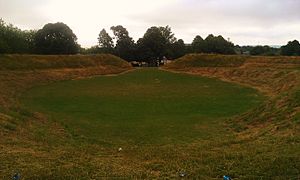
This time was also difficult for people. Forests grew back where farms used to be. Old tombs were closed. Some old enclosures became forts and were even attacked. Experts think there might have been problems like bad harvests or too many people.
The Early Bronze Age
The Bronze Age began when people started using bronze. Bronze is a metal made from copper and tin. Even with this new metal, people kept building stone circles. The change from the Late Neolithic to the Bronze Age was not a sudden one for these builders.
What Stone Circles Look Like
Stone circles are some of the most famous ancient monuments in Britain. Even though we call them "circles," many are actually oval or egg-shaped. They are not always found alone. Sometimes they are near wooden or earth structures.
Archaeologist Alexander Thom grouped stone circles into four types. These were true circles, flattened circles, egg-shaped rings, and ellipses.
Some circles, like Stanton Drew, have paths of stones leading to them. Other stone paths connect different monuments. Sometimes, old wooden posts were replaced with stone ones. This might have made the monuments last longer.
Stone circles are mostly found in Britain and Ireland. They are common where stone is easy to find. But they are not in the very south-eastern part of England. There is a lot of variety in their designs. This is not surprising since they were built over a thousand years.
How They Were Built
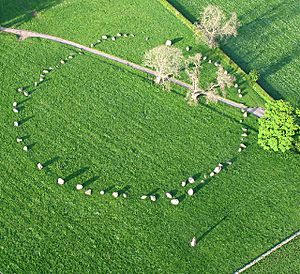
Building a stone circle took careful planning. The builders had to choose the right spot. They also had to decide the size of the ring. Then, they had to move the heavy stones and set them up. This was a huge task! They might have even planned the circles to line up with the sun or moon.
Most circles were built on flat ground. Sometimes, the land was flattened just for the circle. Some circles were placed to make it seem like they were at the center of the world.
We don't know much about how they got the stones. But at one site in Orkney, archaeologists found clues. Stones were cut from rock just below the ground. Then, they were likely moved using wooden rollers and sleds. One stone, weighing over 10 tons, was found ready to be moved.
When They Were Built and How Many
Experts believe that for every stone circle we see today, two others have been lost. So, from the 1,300 circles left, there might have been about 4,000 originally.
Since the 1950s, archaeologists use radiocarbon dating to find out how old things are. This helps them date the stone circles accurately. The earliest known circle dates to about 2525 BCE. The latest ones are from around 700-800 BCE. This means stone circles were built for a very long time, from about 3300 to 900 BCE.
The size of the circles varied a lot. Maybe this depended on how many people would use them. The largest circle is Stanton Drew in Somerset. It is about 112 meters (368 feet) across. The Ring of Brodgar and Avebury are also very large. The biggest circles are often found near older henge monuments. Most circles (92%) were much smaller, about 13.7 meters (45 feet) across.
Ancient Measurements and Stars
Archaeologist Alexander Thom thought the builders used a special unit of measurement. He called it the "megalithic yard," which was about 0.83 meters (2.72 feet). This idea is still debated by experts.
Thom also believed that the builders were good at astronomy. He thought they lined up the circles with the sun, moon, and stars. But many circles don't seem to have these alignments. Still, some of the very first large circles, like Callanish and Stenness, do line up with the sun and moon.
Why Were They Built?
People have wondered about the purpose of stone circles for centuries. There isn't one simple answer.
These circles often show little sign of people visiting them regularly after they were built. This suggests they weren't used for everyday activities. They might have been "silent and empty monuments." Some archaeologists think stone was linked to the dead. Wooden structures might have been for the living.
Evidence of human remains has been found at some stone circles. This suggests they might have been places for the dead. Other experts think the stones might have represented gods or spirits.
Where Are They Found?
There are 1,303 stone circles recorded in Britain, Ireland, and Brittany. Most are in Scotland (508). England has 316, Ireland has 187, and Wales has 81. Brittany has 49, and the Channel Isles have 6.
South-west Britain
Dartmoor has 13 circles, like Brisworthy stone circle. Cornwall has many, such as The Merry Maidens. Exmoor has only two known circles. This might be because Dartmoor has a lot of natural granite, which is good for building. Exmoor does not have much large stone.
Wessex
Wessex is home to the most famous circles: Avebury and Stonehenge. Many other circles in this area are now ruined or destroyed. Most were built on low ground.
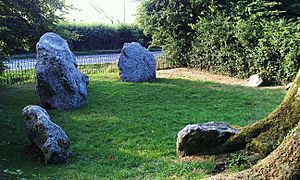
Dorset has a few stone circles, with nine possible examples. They are generally small and oval-shaped. Most are made of sarsen boulders, a type of stone. Experts think these circles were built during the Bronze Age.
Northern England
Northern England, especially Cumbria, has many stone circles. Large ones include Castlerigg stone circle and Long Meg and Her Daughters.
Scotland
Scotland has stone circles everywhere. Famous ones include the Callanish Stones in the Outer Hebrides. Orkney has the Ring of Brodgar and the Standing Stones of Stenness. In Aberdeenshire, some circles have a large stone lying on its side.
Ireland
In southwest Ireland, especially in Cork and Kerry, there are many axial stone circles. These also have a stone lying on its side, usually to the southwest.
Later History
Over time, some stones were taken from the circles to be used for building. Natural events, like tree roots, also moved some stones.
Medieval Times
After Christianity came to Britain, some Christian leaders spoke out against people who still honored stones. This might have included stone circles.
In the Middle Ages, people rarely wrote about these old monuments. They usually only mentioned them for practical reasons. For example, a court might be held near one. A rare story comes from the book History of the Kings of Britain. It claimed that Stonehenge was once in Ireland and was moved by the wizard Merlin.
Studying the Circles
In the 19th century, many early researchers drew plans of the circles. But these drawings were often not very accurate.
Folklore and Stories
Many folk tales and legends grew up around stone circles.
One common story in Britain is about "countless stones." People believed you could never count the exact number of stones in a circle. If you tried, you would always get a different answer. This story was told about Stonehenge and The Hurlers in Cornwall.


